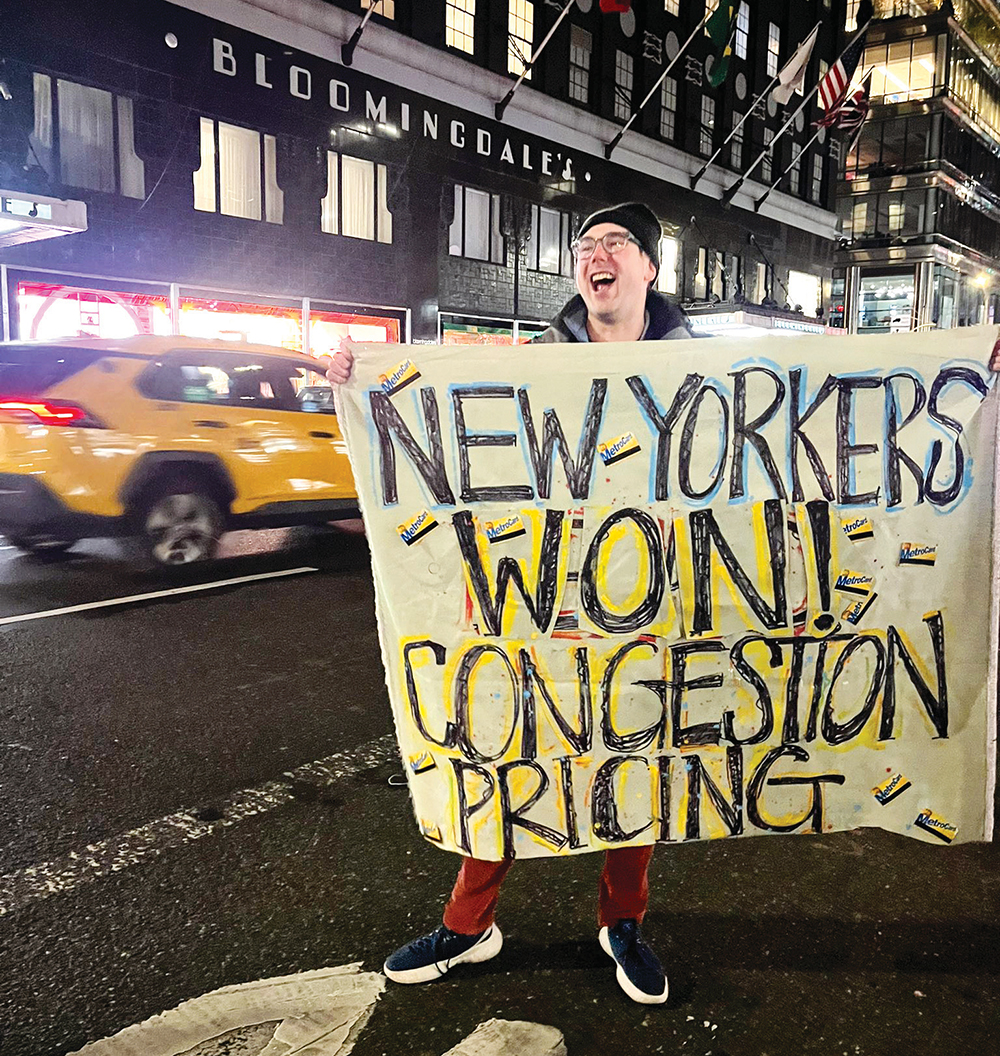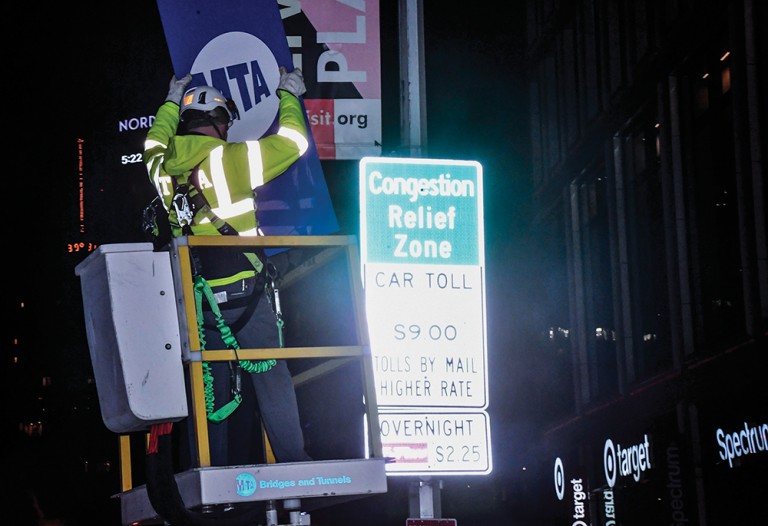By Michael V. Cusenza
Whether you call it a toll, a fee, or another tax, congestion pricing has arrived.
The Metropolitan Transportation Authority on Sunday activated the country’s first congestion pricing program, charging motorists to enter Manhattan below 60th Street, or the Congestion Relief Zone. For drivers using E-ZPass, the peak toll for vehicles entering the CRZ is $9 and the overnight rate is $2.25.
The program was mandated by the State in April 2019 and modeled on urban congestion pricing programs around the world to reduce traffic congestion and raise revenue to improve public transportation.
Outer-borough residents and leaders have blasted the idea since Mayor Mike Bloomberg first floated it back in 2007.
“[Many constituents] just don’t trust the subway system, and going in by car is unaffordable,” City Councilwoman Joann Ariola (R-Ozone Park) told Spectrum News NY 1 on Monday. “No one is happy about this. People have to get into Manhattan and they can’t. Why? Because they cannot afford it.”
Councilman Bob Holden (D-Maspeth) said on Monday he’s “never seen this much outrage over a NY issue like the congestion scam tax—it shows how tone-deaf politicians are.” He added that the MTA and Gov. Kathy Hochul “are pillaging taxpayers to fund the grift and mismanagement of the MTA.” Holden has characterized congestion pricing as “penalizing hardworking middle-class taxpayers and seniors on a fixed income who depend on driving into Manhattan for crucial appointments.”
The MTA has said that the first-in-the-nation program will deliver for the metropolitan area: cleaner air, less traffic, and better public transportation. A study commissioned by the Partnership for New York City in 2018 found that average traffic speeds of just 7 m.p.h. led to 117 hours per person per year wasted sitting in gridlock and annual economic costs—ultimately passed on to consumers—of $20 billion a year. Those trends have continued, with New York currently ranked as the most congested city in the world, as reported last year by the New York Post, putting New York in the same position as London was before officials there implemented congestion pricing in 2003.
According to the authority, congestion pricing is projected to lead to 80,000 fewer vehicles entering the Congestion Relief Zone every day, resulting in less traffic, cleaner air, and safer streets, while providing $15 billion in funding for critical transit investments.

Photo Courtesy of Yosef Kessler
A congestion pricing supporter hails the program’s launch early Sunday morning.
Eighty percent of the revenue generated will go to capital improvements on NYC Subways and Buses, 10 percent to Metro-North Railroad and 10 percent to the Long Island Rail Road.
A phased-in toll plan that starts at 40-percent of the eventual toll enables the MTA to issue $15 billion in bonds to fund the MTA’s 2020-2024 Capital Plan and advance critical capital projects helping subway, bus, commuter rail riders and motorists alike. After the pause on congestion pricing was lifted, the MTA exercised the option to purchase 265 zero-emission buses on Nov. 27.
Additionally, the MTA said, congestion pricing unlocks investments in bridges and tunnels that were had been put on hold pending the start of the program.
“We want to encourage trucks to do more deliveries at night, we want improvements to vehicle speeds especially for buses, we want to make sure that emergency response vehicles can get where they are going faster, and I hope drivers will take another look at the speed and convenience of mass transit,” said MTA Chairman and CEO Janno Lieber.
City Transportation Commissioner Ydanis Rodriguez added, “Congestion pricing will reduce traffic, improve our air quality, and increase street safety all while generating critical revenue to modernize the MTA’s subway and bus systems,” said NYC DOT Commissioner Ydanis Rodriguez. “We are closely coordinating with the MTA on the rollout of congestion pricing this weekend and we continue to work to reimagine our streets, making it easier than ever to travel to and through Manhattan’s core without a car.”
Now that it has been implemented, even congestion pricing’s most ardent supporters have demanded that the MTA and Hochul deliver on their promises.
“A generation of straphangers, transportation advocates, and public servants has fought tirelessly for a solution to ease gridlock, lower emissions, and fund desperately needed subway improvements,” said City Comptroller Brad Lander, a 2025 candidate for mayor. “The only way to bring doubters on board is to show real, concrete improvements—and to do it quickly and transparently.”
Lander said the MTA needs to move faster and more efficiently than it has in the past to install: new subway elevators to make the system more accessible; modern signals and new cars to make it more reliable; and platform barriers and station gates to make the subway safer.
“And we need honest, transparent data on how congestion pricing is actually working: what the reductions in traffic really are, how much drivers are paying, whether the toll structure is working,” Lander added. “No one loves paying a new toll, but it matters a lot when they can see whether it’s fairly applied, and where the money is going. So the MTA can’t hide the ball. They’ve got to provide honest data, be open to making tweaks if necessary, and prove to people that it’s really working.”
Ariola has said that she believes that the fallout from the new toll program will be severe.
“This is something that places an undue burden on residents of the outer boroughs, and forces them to pay an additional tax for their choice to travel to Manhattan. In a city where subway crime is constantly in the headlines, and many New Yorkers—especially women and the elderly—feel unsafe on public transportation, the car is really the only viable mode of access to get to stores, restaurants, medical appointments, and entertainment venues on Manhattan Island,” the councilwoman said in remarks delivered at an MTA public hearing back in March. “Congestion pricing will be a disaster for everyone in this city, and the problems it seeks to rectify pale in comparison to the problems it will cause. This is why I believe that we need to abandon this endeavor, and go back to the drawing board to find solutions that can truly work for all New Yorkers.”
Councilwoman Vickie Paladino (R-Whitestone) said on Tuesday that “nothing is going to improve with congestion pricing.
“The MTA is a disaster, they still have a $33 billion hole in their budget, and even if it somehow gets filled by even more taxes, they are simply incapable of a course correction. That’s just a fact. Shoveling tens of billions at this agency without any concrete demand for accountability or a change in management was never going to yield any results,” Paladino added. “And regular New Yorkers lose again.”

